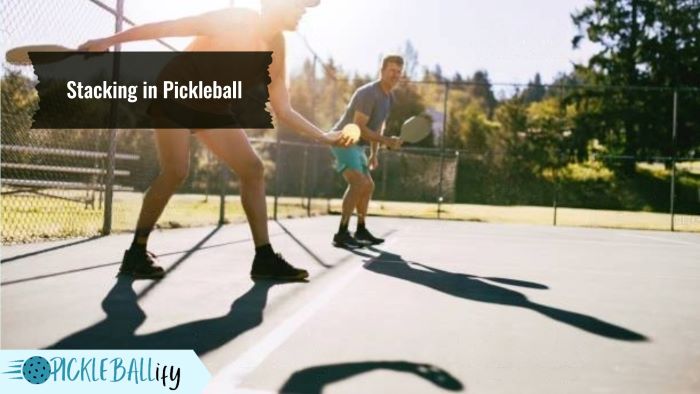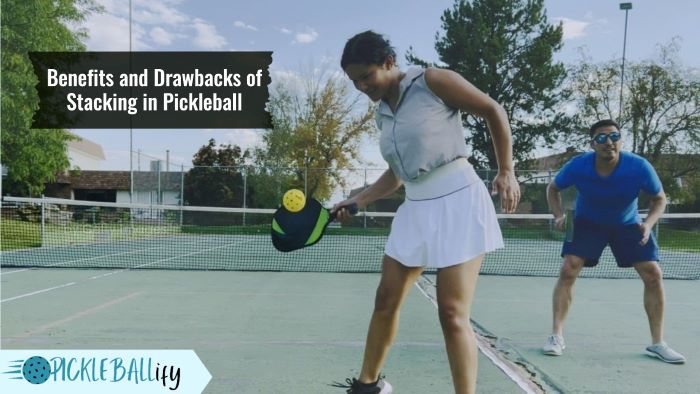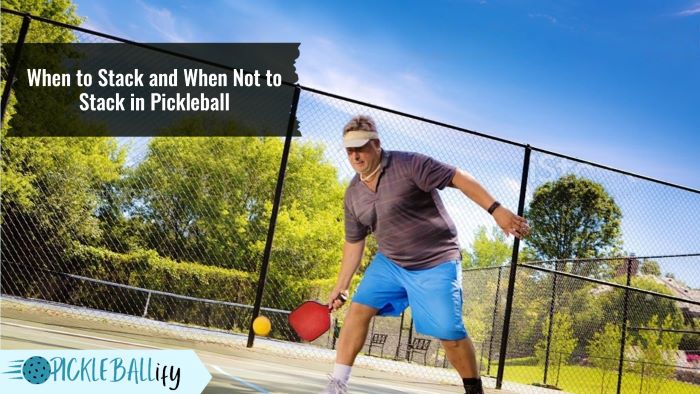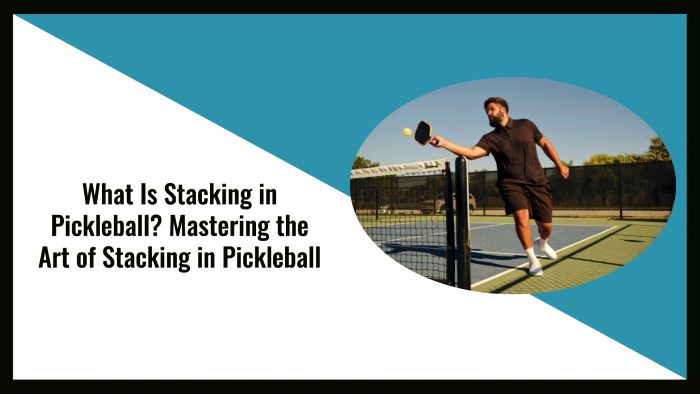Pickleball is a fun and exciting sport that combines elements of tennis, badminton, and table tennis. It can be played by people of all ages and skill levels, and it offers many benefits for your health and fitness.
But if you want to take your pickleball game to the next level, you need to learn some strategies and tactics that can give you an edge over your opponents. One of these strategies is called stacking.

Stacking in pickleball is a doubles strategy where both players on a team line up, or stack, on the same side of the court before a serve or return. After the ball is hit, each player shifts to their desired side; this formation improves mobility and controls where you stand on the court. Stacking can help you maximize your strengths, hide your weaknesses, and confuse your opponents.
In this blog post, we will explain what stacking is, why it is beneficial, how to do it, when to use it, and what to avoid. By the end of this post, you will have a better understanding of stacking in pickleball and how it can improve your game.
What is Stacking in Pickleball?
Stacking in pickleball is a tactic that uses two (or more) players to force the opposing team into difficult plays. This can include:
- Playing one player deep and the other short to maximize both offensive and defensive coverage.
- Using two players to cover either 2 or 1 opponent.
- Forcing your opponent to use their non-preferred hand or side of the court.
Stacking is primarily used on serve receive, although it can be employed during other phases of the game as well (such as transition and baseline). It’s especially useful on serves hit deep in the corner with an angle.
But stacking isn’t always a good idea – it can be risky if your opponents have a lot of experience playing pickleball.
“Stacking in pickleball is a doubles strategy where both players on a team line up, or stack, on the same side of the court before a serve or return” Stated in GrandPicklebalClub.
Here is an example of how stacking works:
Let’s say you are playing doubles with your partner against another team. You are both right-handed players, and you prefer to play on the right side of the court. Your opponents are also right-handed players, and they prefer to play on the left side of the court.
You are receiving serve from the left service box. Instead of standing on your usual side (the right), you and your partner stack on the left side of the court. This way, you can both use your forehands to return the serve.
The server hits a deep serve to the corner of your service box. You move back and hit a crosscourt return with your forehand. Your partner moves up to the net and covers the middle.
The server’s partner tries to volley your return, but he has to use his backhand because he is on his non-preferred side (the right). He hits a weak shot that lands in front of your partner. Your partner smashes it down for a winner.
How to Stack in Pickleball: A Step-by-Step Guide
Stacking might sound complicated at first, but it’s actually quite simple once you get the hang of it. Here are some basic steps to follow:
- Decide who will play on which side of the court. For example, let’s say you want to play on the right-hand side and your partner wants to play on the left-hand side.
- If you are serving, both players stand on the same side of the center line before the serve. The server stands behind the baseline and serves diagonally across the court as usual. The partner stands near the center line and does not cross it until after the serve. For example, if you are serving from an even score (0-0-2), both players stand on the right-hand side of the court before the serve.
- After the serve, both players move to their desired side of the court. The server moves toward the center line and then crosses it to reach their side. The partner moves toward their side as well. For example, after serving from an even score (0-0-2), both players move to their respective sides: you move to the right-hand side and your partner moves to the left-hand side.
- If you are receiving, both players stand on their desired side of the court before the return of serve. The receiver stands behind the baseline and returns the serve diagonally across the court as usual. The partner stands on their side and can cross the center line after the return of serve. For example, if you are receiving from an odd score (0-1-1), both players stand on their respective sides before the return of serve.
The Benefits and Drawbacks of Stacking in Pickleball
Stacking in pickleball can be a very effective strategy if done correctly and with good communication. Some of the benefits of stacking are:
- Regardless of the outcome of the game, you are free to play on your favorite side of the court the whole time. You may feel more at ease and certain on the court as a result.
- According to your choice and strength, you can utilize either your forehand or your backhand more frequently. You can make shots that are more powerful and accurate by doing this.
- You may shoot from more angles and cover more ground. By doing so, you might exert additional pressure on your adversaries and force them into errors.
- You can create favorable combinations and stay away from negative ones. By doing this, you may take advantage of your rivals’ flaws and avoid their advantages.
- You can catch your opponents off guard and interfere with their rhythm. You can acquire an advantage and alter the game’s momentum by doing this.

However, stacking also has some drawbacks that you should be aware of. Some of the drawbacks of stacking are:
- At all times, you must keep in mind who is the proper server and recipient. If you’re not used to stacking, this may be difficult and unpleasant.
- You must coordinate your moves with your partner and have good communication. This may be challenging and hazardous, especially if you don’t know each other’s preferences and styles.
- Immediately following every serve or return of serve, you must act fast and effectively. This can be tough and exhausting, especially if your mobility is restricted or you are not in good physical condition.
- Depending on whatever side of the court you are on, the ball will spin and bounce differently for you. This can be challenging and irritating, especially if you lack the necessary knowledge or expertise.
When to Stack and When Not to Stack in Pickleball: Tips and Tricks
Pickleball stacking can be a strong technique, but it is not a magic pill that will ensure you victory. Stacking is more beneficial in certain contexts than others, while it is not recommended in others.
Here are some tips and tricks on when to stack and when not to stack in pickleball:
- When you have a definite edge over your opponents, stack. If you have a powerful forehand or a left-handed partner, for example, stacking might help you capitalize on these abilities and put pressure on your opponents.
- When you want to surprise or confuse your opponents, stack. For example, if you’ve been playing traditionally for the majority of the game, switching to stacking may take your opponents off a surprise and interrupt their rhythm.
- When you wish to prevent weakness or disadvantage, stack. Stacking, for example, might help you cover more ground and avoid revealing your vulnerability if you have a weak backhand or a partner who is wounded or exhausted.

- When your opponents are seasoned or good players, do not stack. They might be able to deal with your stacking method and counter it with their own. They may also be able to take advantage of the holes or weaknesses created by stacking on your side of the court.
- Stack only when you are comfortable and secure with it. Stacking demands strong partner coordination and communication, as well as fast movement and placement. If you are unfamiliar with or practice stacking, you may end yourself making more mistakes or losing points.
- Stacking is not always required or beneficial. Stacking may not always provide a major benefit or may even put you at a disadvantage. Stacking, for example, may not be worth it if your opponents have a poor serve or return, or if they do not hit to the middle of the court.
FAQs
In pickleball, players stack to achieve a strategic advantage. Players can boost their chances of gaining points by placing themselves such that their stronger side faces the net. Stacking can also break the opponents’ rhythm and cause them to modify their strokes.
No, according to pickleball’s official regulations, only one player can stack at a time. The stronger player will often stack on the other side of their dominating hand, while the other player will remain on the opposite side of the court.
Yes, stacking can be used in both doubles and mixed doubles pickleball. In doubles, one player from the team can stack to the opposite side of their dominant hand, while in mixed doubles, the decision on who will stack can be made based on each player’s skill level and preference, regardless of gender.
No, stacking is not a formal rule in pickleball. It is a strategic technique employed by players to gain an advantage over their opponents. However, it is important to adhere to the official rules of pickleball, including only stacking once during each server’s turn and returning to the original sides of the court after the serve.
Well, It’s a Wrap
In conclusion, stacking in pickleball is a strategic positioning of players on the same side of the court to maximize their strengths and gain an advantage over their opponents.
While it is not a formal rule, it is commonly used in competitive play by skilled players who understand their partner’s abilities and can coordinate their positioning effectively.
Stacking can offer benefits such as optimized shot selection and increased court coverage, but it also requires good communication, coordination, and awareness of the opponent’s strategies.
Understanding the concept of stacking can enhance a player’s strategic approach to pickleball and potentially improve their chances of winning points. However, it’s important to always adhere to the official rules of pickleball and maintain good sportsmanship on the court.

